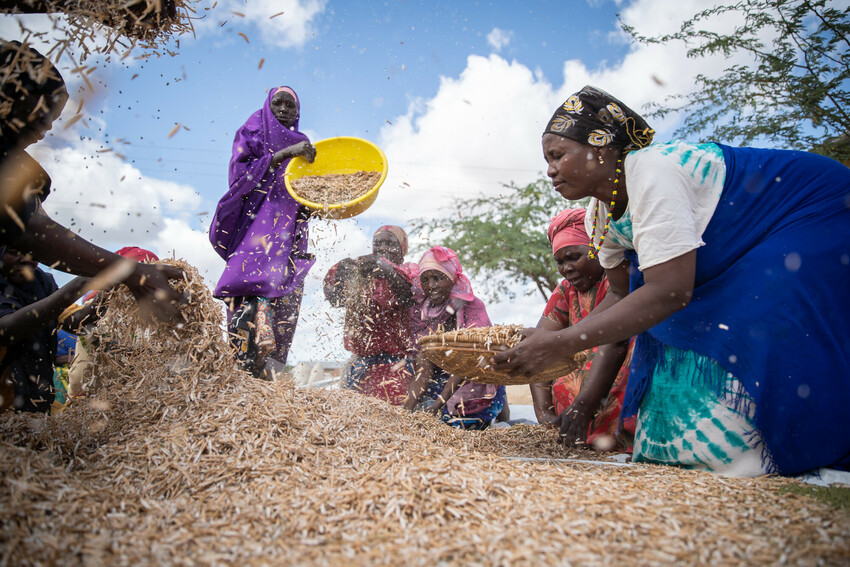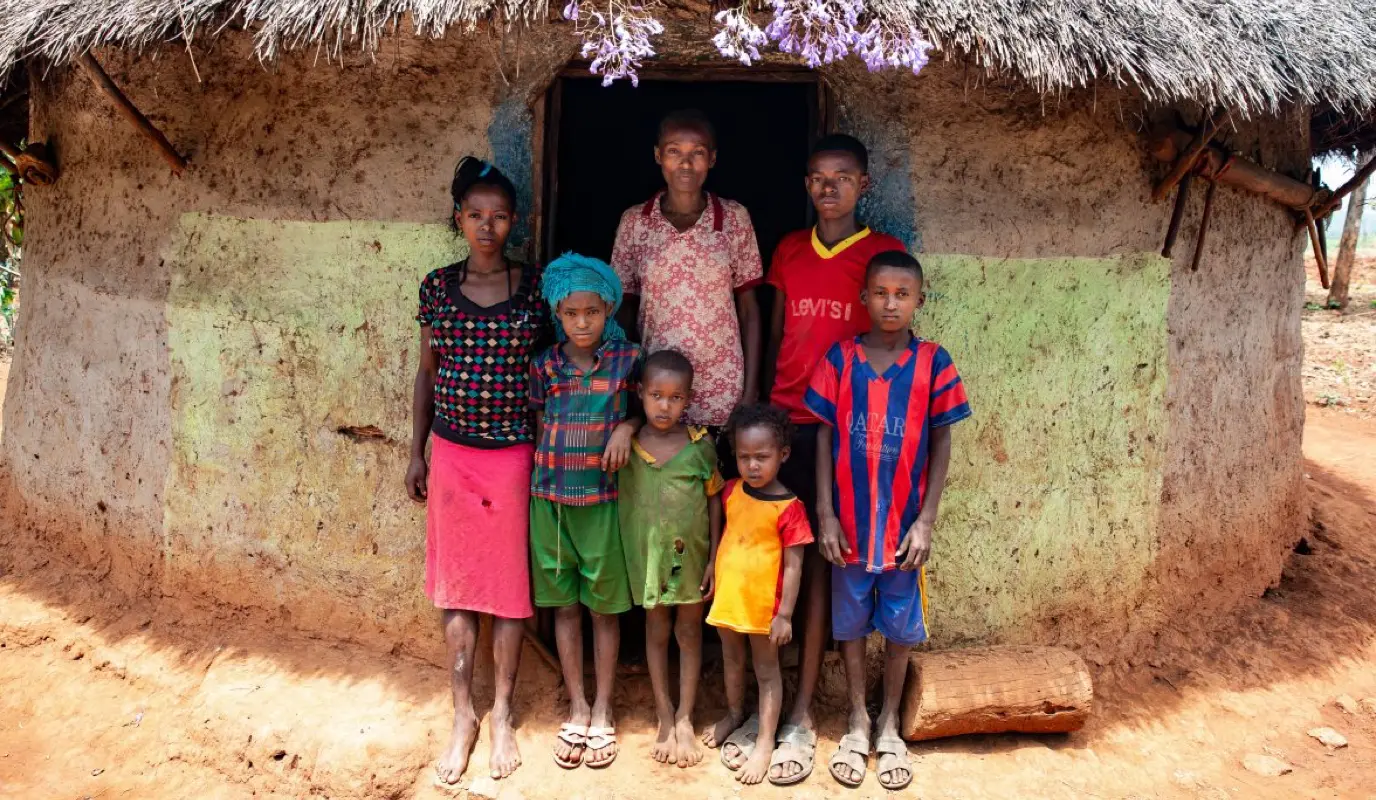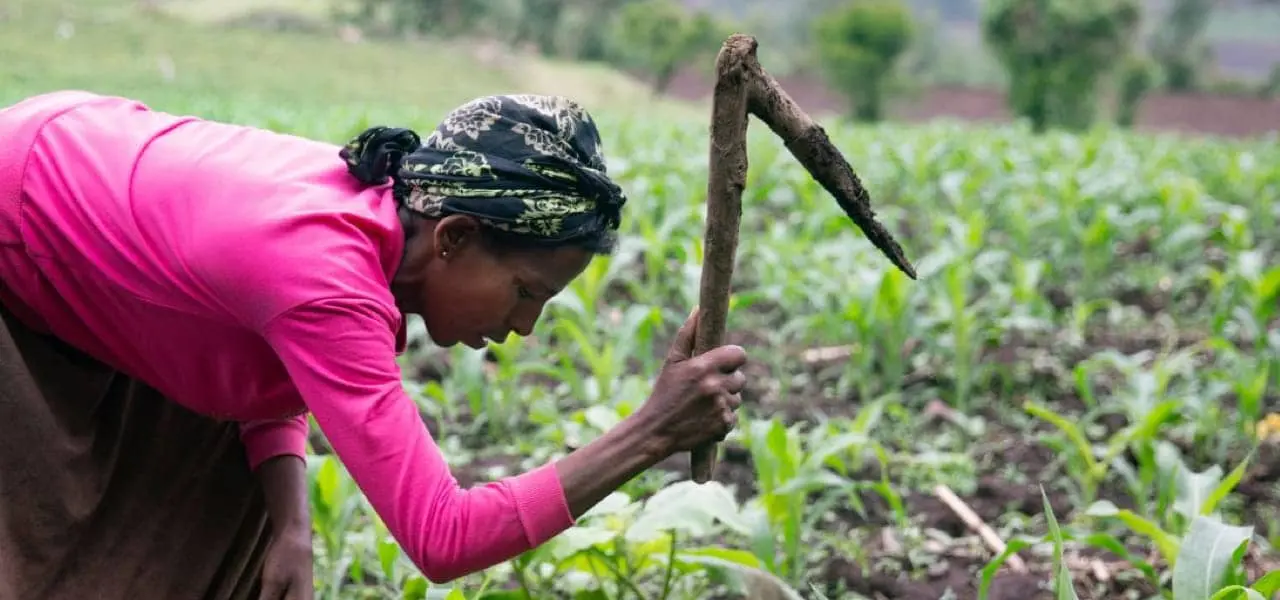The Challenge
The effects of climate change and malnutrition go hand-in-hand. Poor rainfall and less predictable weather patterns reduce harvest yields which leads to less food on the table, less produce at market, and less feed for livestock.
This combination also fuels the cycle of poverty as it passes from one generation to the next: while poverty alone does not cause malnutrition, there are links between poverty and malnutrition levels. Children who suffer from chronic malnutrition are less likely to reach their full potential in life and break the cycle of poverty. Acute malnutrition can mean that a child won’t survive infancy.
We can see how the causes link to a lifetime — if not several generations — of consequence. How do we break those links?
"It's a big worry, brought on to a large extent by a lack of water."
Turning Over a New Leaf
The semi-arid region of Tana River County, Kenya (about six hours drive east of Nairobi) is one of those areas where cause and consequence were in lockstep. Historically, the region has relied on small farming and pastoral livestock to get by on just enough income and food. But climate change has made “getting by” a much harder task over time.
“There isn’t enough,” Halima Diramu Jilu, who has witnessed this shift firsthand, told us at the beginning of 2020. “It’s a big worry, brought on to a large extent by a lack of water.” The issue was clear: With a lack of rainfall animals had less pasture to graze, and families struggled to cultivate crops at any meaningful scale.
The effects rippled out from there: Health clinics in the area began reporting an alarming rise in the levels of malnutrition among young children.

Designing a Community-Based Solution
Concern has worked in Kenya since 2002 and in that time, we’ve built relationships and trust in the communities we serve. Faced with this mounting threat, we sat down with community leaders and local government officials to come up with potential solutions.
From those conversations came LEAF, a dual-pronged approach to addressing hunger through two simultaneous actions:
- Lifesaving treatment for acutely malnourished children and pregnant/lactating women
- Preventing future cases of malnutrition through sustainable livelihoods that allow people living in poverty and marginalization to generate long-term incomes
The underlying goal that connects these two initiatives: improving food and nutrition security for communities in Tana River. Making this plan a reality was possible through funding from Illinois-based food ingredients company Archer Daniels Midland (ADM).
Part One: Lifesaving Nutrition Treatment in Real-Time
First, we needed to address the current levels of malnutrition. As we’ve known over the last 20+ years thanks to CMAM, community-level outreach is a critical ingredient in detecting and treating acute malnutrition in a timely manner.
In cooperation with the Tana River County Government Department of Health, Concern supported trained community health volunteers and assistants to conduct screenings for malnutrition. Through monthly house visits, they would provide a quick checkup for children and pregnant/lactating women, referring those who showed signs of malnutrition to local care centers. They also provided counseling and education on key health and nutrition practices to parents and caregivers.
While these home visits were affected in 2020 by lockdown measures, by the conclusion of the program in 2021 community health volunteers and assistants saw an average of 82% of the 3,200 families in the region every month. Overall, 87% of children under five years of age were screened on a monthly basis.
Even with the realities of social distancing and lockdowns, over 2,600 families were visited each month for at-home nutrition screenings and counseling.
Part Two: Laying the Groundwork For a Lifetime of Health
While addressing current nutrition issues is a major success of this program, it is just one part of LEAF; the other half of the project is geared towards larger changes that will reduce malnutrition from one generation to the next. Across 25 villages, Concern has worked with local farmers to adapt their agriculture methods in the face of a changing environment with Climate Smart Agriculture initiatives and advice specific to their individual situations. In addition, the Concern team worked with pastoralists who had little experience of agriculture to help them develop the skills needed to grow their own food.
We provided drought-tolerant seeds based on each family’s preferred varieties (including maize, black-eyed peas, mung beans, tomatoes, kale, and watermelon) and tailored our level of support to ensure inclusivity. We also began providing pumps and ensuring access to irrigation canals so villages could improve their irrigation capacities and affordable access to water.
"Our aspiration is to have an acre and a half of land under cultivation for each family, providing enough food for their own use and for commercial purposes."
A Powerful Combination
“Since we started this project, our lives have changed,” Halim Diramu Jilu told us mid-project. “We have planted lots of crops. We get water from canals; we have enough water now.”
Halim’s enthusiasm reflects one of the main reasons LEAF has been a success: community ownership. In just 18 months, Tana River County has grown — in many cases literally. We directly reached 39,704 Kenyans across 25 villages. Our initial goal had been to work with 6,000 families; we worked with 6,404. Collectively, over 22,700 pounds of seeds were distributed, from which 1.67 million pounds of crops were harvested. Additionally, the Climate Smart techniques employed reduced crop losses from 60% to under 20%.
At the same time, the area’s child malnutrition rate dropped from 4% in March 2020 to 1% in March 2021, with rates among pregnant and lactating women decreasing from 4% to 2% in the same period.
But perhaps one of the biggest wins was that, for the first time in three decades, there was no relief food distribution in the communities where we worked.
The combination of simultaneously tackling cause and consequence is a powerful one.

LEAF In Ethiopia
While LEAF was initially developed for a specific challenge in a specific region, it ran simultaneously in both Kenya and 1,000 miles to the north in Ethiopia.
Ethiopia’s Wolayita zone faces a different set of challenges, including a denser population that places serious pressure on available land. Mothers like Tarkuwa Debsa are left with a plot of land that’s less than the size of the average US backyard to feed a family of 6 children and generate an income.
“Finding food for them is a challenge. Not only food, I have to send them to school, so life is very, very hard,” Tarkuwa told us. “It is a matter of survival — I am trying to survive.”
Different Methods, Similar Success
LEAF was adapted for Ethiopia to address situations like Tarkuwa’s, using a variation on our Graduation model to help people most prone to risk and inequality to build up their assets, increase their income, and break the cycle of poverty. With the right coaching, mentoring, and startup funding, there is a huge potential in transforming the lives of poor households out of chronic poverty.
During the 18 months of LEAF in Ethiopia, we met our targets for families reached with both cash transfers and skills training. This includes 624 female-led households, which led to an increase in confidence and economic participation among women in Wolayita.
Sowing the Seeds for Future Success
Tarkuwa’s was one of those female-led households. Inspired by her neighbor’s success in Concern’s Graduation program, she participated in the LEAF Project. Through this, Tarkuwa harvested over 550 pounds of navy beans and over 110 pounds of the local grain teff — enough to feed her family and sell the surplus for profit. She also used her start-up capital from LEAF to purchase four goats, which has led to another monthly income, and participates in her local savings and credit cooperatives (SACCO).
“Now, I am able to send my children to school, feed them nutritious food, and engage in social institutions like SACCOs for better financial access,” Tarkuwa tells us, adding that she is now able to provide for her family just as well as her husband did before he died three years ago.
"Now, I am able to send my children to school, feed them nutritious food, and engage in social institutions like Saccos for better financial success."
On average, households participating in LEAF Ethiopia are now making $40 to $50 each month in profits from their new businesses and saving an average of $50 to $150 through their local village economic and social associations. These gains are significant, both for now and the future: Many families in LEAF had no savings prior to joining, and often took loans from local moneylenders with interest rates higher than 100%.
Our Partners
Our Supporters
Your Support
Your tax-deductible gift makes you part of a vital community that enables us to reach 25 million people each year with life-saving and life-changing interventions that tackle poverty and its causes — including climate change and hunger. The end of poverty is possible within our lifetime. Your support can make it happen.



